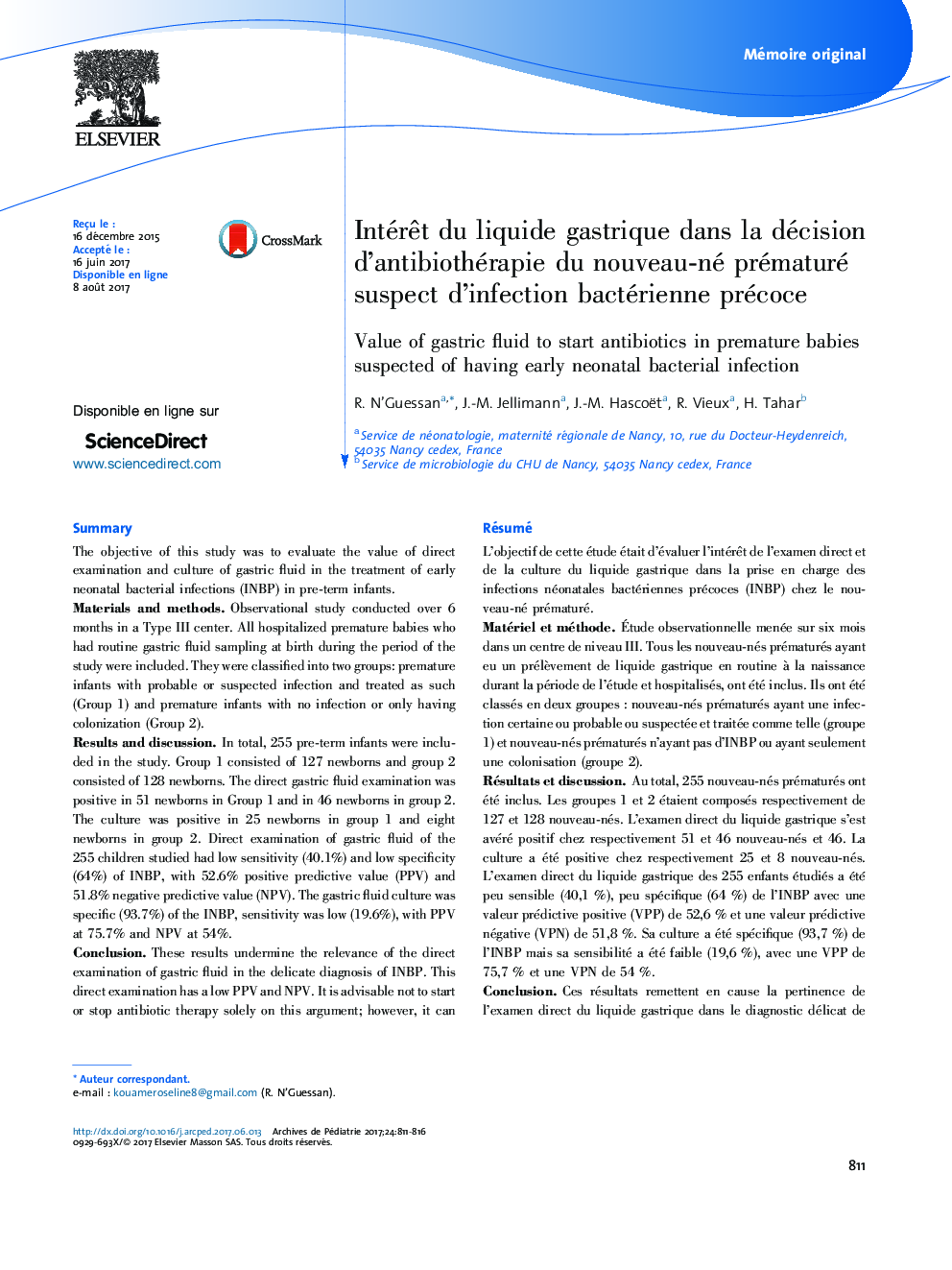| کد مقاله | کد نشریه | سال انتشار | مقاله انگلیسی | نسخه تمام متن |
|---|---|---|---|---|
| 5717368 | 1411198 | 2017 | 6 صفحه PDF | دانلود رایگان |

RésuméL'objectif de cette étude était d'évaluer l'intérêt de l'examen direct et de la culture du liquide gastrique dans la prise en charge des infections néonatales bactériennes précoces (INBP) chez le nouveau-né prématuré.Matériel et méthodeÃtude observationnelle menée sur six mois dans un centre de niveau III. Tous les nouveau-nés prématurés ayant eu un prélèvement de liquide gastrique en routine à la naissance durant la période de l'étude et hospitalisés, ont été inclus. Ils ont été classés en deux groupes : nouveau-nés prématurés ayant une infection certaine ou probable ou suspectée et traitée comme telle (groupe 1) et nouveau-nés prématurés n'ayant pas d'INBP ou ayant seulement une colonisation (groupe 2).Résultats et discussionAu total, 255 nouveau-nés prématurés ont été inclus. Les groupes 1 et 2 étaient composés respectivement de 127 et 128 nouveau-nés. L'examen direct du liquide gastrique s'est avéré positif chez respectivement 51 et 46 nouveau-nés et 46. La culture a été positive chez respectivement 25 et 8 nouveau-nés. L'examen direct du liquide gastrique des 255 enfants étudiés a été peu sensible (40,1 %), peu spécifique (64 %) de l'INBP avec une valeur prédictive positive (VPP) de 52,6 % et une valeur prédictive négative (VPN) de 51,8 %. Sa culture a été spécifique (93,7 %) de l'INBP mais sa sensibilité a été faible (19,6 %), avec une VPP de 75,7 % et une VPN de 54 %.ConclusionCes résultats remettent en cause la pertinence de l'examen direct du liquide gastrique dans le diagnostic délicat de l'INBP. Il convient de ne pas instaurer ou arrêter une antibiothérapie uniquement sur cet argument, cependant il peut orienter le choix de l'antibiothérapie et garde un intérêt pour cette raison. La culture du liquide gastrique a une très bonne spécificité (93,7 %).
SummaryThe objective of this study was to evaluate the value of direct examination and culture of gastric fluid in the treatment of early neonatal bacterial infections (INBP) in pre-term infants.Materials and methodsObservational study conducted over 6 months in a Type III center. All hospitalized premature babies who had routine gastric fluid sampling at birth during the period of the study were included. They were classified into two groups: premature infants with probable or suspected infection and treated as such (Group 1) and premature infants with no infection or only having colonization (Group 2).Results and discussionIn total, 255 pre-term infants were included in the study. Group 1 consisted of 127 newborns and group 2 consisted of 128 newborns. The direct gastric fluid examination was positive in 51 newborns in Group 1 and in 46 newborns in group 2. The culture was positive in 25 newborns in group 1 and eight newborns in group 2. Direct examination of gastric fluid of the 255 children studied had low sensitivity (40.1%) and low specificity (64%) of INBP, with 52.6% positive predictive value (PPV) and 51.8% negative predictive value (NPV). The gastric fluid culture was specific (93.7%) of the INBP, sensitivity was low (19.6%), with PPV at 75.7% and NPV at 54%.ConclusionThese results undermine the relevance of the direct examination of gastric fluid in the delicate diagnosis of INBP. This direct examination has a low PPV and NPV. It is advisable not to start or stop antibiotic therapy solely on this argument; however, it can guide the choice of antibiotic therapy and remains useful for this reason. The culture of gastric fluid has very good specificity (93.7%).
Journal: Archives de Pédiatrie - Volume 24, Issue 9, September 2017, Pages 811-816